Canadian Aquaculture R&D Review 2015
Table of Contents
Shellfish: Oysters
BAY-SCALE FILTRATION OF CULTIVATED OYSTERS IN RELATION TO TIDAL FLUSHING AND PHYTOPLANKTON RENEWAL
With the recent expansion of oyster (Crassostrea virginica) culture within Village Bay, New Brunswick, there were concerns that this oyster population may be filtering phytoplankton from the bay faster than it could be replenished. To address this concern, this project examined the filtration capacity of oysters against the renewal rates of water and phytoplankton within the bay. Modelling tools were used to describe the relationship between a breach opening in the sand dune occurring at the head of the bay and its potential effect on food fluxes.
The results of the modelling showed that phytoplankton production within Village Bay is greater than that brought in by the tides and currents, suggesting that food production within the bay is sufficient to support existing oyster culture levels. Only 10–30% of water movement in the bay could be attributed to the breach. This suggests that, currently, the breach has very little impact on the water movement within the bay, and that the majority of the oyster food is being produced within the bay rather than coming from outside waters entering through the breach.
This research has provided relevant information to regulators to ensure the effective management of this industry and to help determine whether further expansion of the oyster culture operations should occur in Village Bay. Future studies should continue to monitor the breach to determine the potential effect of further erosion on food availability within the bay.
Apr. 2010–Mar. 2013
Funded By: DFO – Aquaculture Collaborative Research and Development Program (DFO – ACRDP) Co-Funded By: King Aquaculture
Project Leads: Rémi Sonier, Luc Comeau (DFO)
Collaborators: King Aquaculture
Contact: Remi.Sonier@dfo-mpo.gc.ca, Luc.Comeau@dfo-mpo.gc.ca
www.dfo-mpo.gc.ca/aquaculture/acrdp-pcrda/index-eng.htm

Spatial distribution of the Seston Depletion Index (SDI) predicted by the model in the actual conditions of oyster culture development, primary production, and water renewal. Where yellow = approx 20% depletion, dark blue = 80% production (Guyondet et al., submitted).
INVESTIGATING POLYDORA OUTBREAK IN NEW BRUNSWICK OFF-BOTTOM CULTURED OYSTERS
A better understanding of the increased intensity and prevalence of Polydora related to environmental conditions and their impact on oyster health would assist industry in developing management and mitigation strategies.
Known simply as a “mudworm” or “blisterworm”, Polydora websteri has the ability to bore into the shells of live and dead shellfish. Commonly found in intertidal and subtidal areas in Atlantic Canada, its presence among New Brunswick oyster populations has normally been minor and usually of low intensity with burrows containing little or no mud. However, there have been sporadic increases of infestation rates observed in off-bottom (or suspension) oyster growing sites in New Brunswick. Some reports have indicated that heavy infestations can result in low meat quality, abscesses, alteration of growth patterns, and weakened shells (increasing predator susceptibility). This unusual increase could ultimately lead to serious impacts on oyster populations and result in economic losses for the aquaculture industry. To help identify the current impact of Polydora on New Brunswick oyster growing areas, this project aims to: (1) document the presentation and level of the infestation of Polydora; (2) document the impact of Polydora on overall oyster health; and (3) document distribution and infestation level of Polydora in relation to environmental conditions.
Apr. 2014–Mar. 2016
Funded By: DFO – Aquaculture Collaborative Research and Development Program (DFO – ACRDP) Co-Funded By: Huîtres Aquador Oysters Inc.
Project Leads: Daniel Bourque, Mary Stephenson (DFO)
Collaborators: Huîtres Aquador Oysters Inc.
Contact: Daniel.Bourque@dfo-mpo.gc.ca, Mary.Stephenson@dfo-mpo.gc.ca
www.dfo-mpo.gc.ca/aquaculture/acrdp-pcrda/index-eng.htm
OYSTER CULTURE AS ADDITIONAL PRODUCTION TO SHELLFISH AQUACULTURE
The objective of this project is to assess the bio-technical feasibility of this culture in the Îles de la Madeleine and the Gaspé Peninsula. To do this, the study was divided into three components. Component A’s specific objective was to test three suspension culture techniques with two oyster size classes (30–40 mm and 50–60 mm) and two oyster stocks (Bouctouche and Caraquet). These three techniques were assessed By: (1) comparing oyster survival and growth; (2) evaluating oyster quality; and (3) evaluating the time required for the oysters in each size class to reach the minimum market size (cocktail) (> 65 mm). Component B concerned oyster conditioning. The sexual maturation potential for oysters during the summer in the cold waters of the Gaspé Peninsula and the Islands was assessed. Component C assessed the technical/economic feasibility of such culture in Quebec’s coastal waters.
Unlike the results from the Gaspé Peninsula, the results from the Islands are very encouraging. Oysters (50–60 mm) purchased in Bouctouche and farmed in the Havre-aux-Maisons lagoon had an average growth of 28 mm and 25 mm over two years when tested on ropes and in lantern nets, respectively. The result is similar for Bouctouche oysters with an initial size of 30–40 mm, growing to 31 mm in two years. Recovery rates (including losses through mortality and fall-off) were over 80% in the first year and 53% after the second year for rope-grown oysters. These rates were even more encouraging for oysters placed in lantern nets.
Oct. 2011–Dec. 2014
Funded By: Economic Development Canada for Quebec Regions (EDC); Innovamer program (MAPAQ)
Lead: Lisandre Solomon (Merinov)
Project Team: Isabelle Lemieux (Gaspé Peninsula lead); Carole Cyr, Aurelie Licois
Collaborators: La moule du large Inc., Moule de Culture des Îles Inc.
Contact: Lisandre.Solomon@merinov.ca

Rope-grown oysters. Photo: Lisandre Solomon
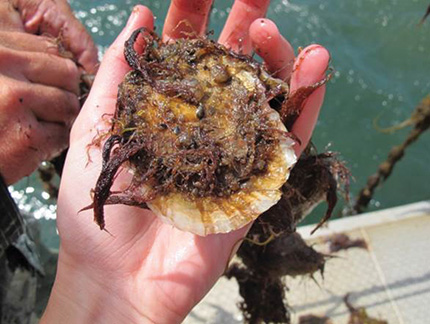
Photograph of buried oyster that successfully managed to expulse the overlying silt away from its shell edge. Photo: Luc Comeau (DFO)
SEDIMENT-COVERED EASTERN OYSTERS, CRASSOSTREA VIRGINICA
In Gulf of St. Lawrence estuaries, mesh bags containing cultivated oysters are lowered onto the estuarine seabed. This is initiated in October/November and recovered five to six months later, i.e., after the thick winter ice cover breaks up and moves offshore. Oyster farmers periodically report mortalities when bags are recovered from the seabed in the spring. The dead oysters have dark gaping shells containing black anoxic sediments and traces of still-decomposing tissues. It is suspected that oysters are vulnerable to sedimentation and burial during the winter period, when they remain unattended for a prolonged period of time.
Presently there are no industry guidelines with respect to the optimal timing for either lowering bags onto soft bottoms in autumn or recovering these bags in spring. Some growers lower bags in early October to avoid autumnal storms and the breaking of new shell growth. Others wait until the water temperature falls below 4˚C and oysters become metabollicaly quiescent. This project will assess whether: (1) there is a cause-effect relationship between winter burial and oyster health; and (2) the timing of burial in autumn has any modulating effect on winter survival.
Jul. 2014–Mar. 2016
Funded By: DFO – Aquaculture Collaborative Research and Development Program (DFO – ACRDP) Co-Funded By: L’Étang Ruisseau Bar Ltd.
Project Lead: Luc Comeau (DFO)
Project Team: André Mallet, Claire Carver (L’Étang Ruisseau Bar Ltd.)
Collaborators: Jeffrey Davidson (UPEI)
Contact: Luc.Comeau@dfo-mpo.gc.ca
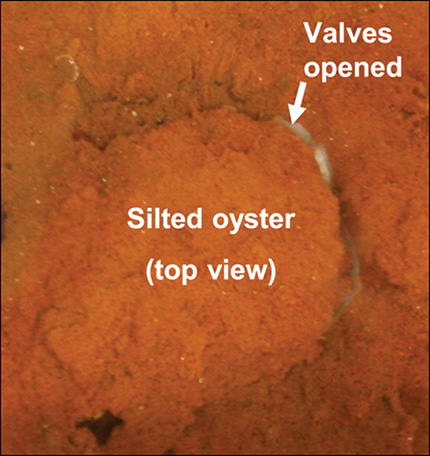
Photograph of buried oyster that successfully managed to expulse the overlying silt away from its shell edge. Photo: Luc Comeau (DFO)
USE OF EELGRASS AS A MITIGATION STRATEGY FOR EFFECTS OF OCEAN ACIDIFICATION ON OYSTER FARMS
Preservation, restoration, and conservation of eelgrasses has been proposed by various governmental agencies as a remediation strategy for coastal habitats impacted by ocean acidification (OA), but this hypothesis has not been tested. This is one of the first tests to examine whether it will be a viable remediation option.
Climate change has been associated with declines of coastal organisms and this is impacting wild and farmed fisheries. In the case of organisms with calcifying shells, OA is a particular threat and has led to closures of oyster aquaculture sites and production losses. This is not only an economic loss, but an ecological one as well, as oysters provide numerous ecosystem functions, including water filtration and formation of reef habitats. One possible mitigation strategy for OA in soft sediment coastal habitats is by co-culturing seagrass species with OA sensitive species. Seagrasses can grow faster in high CO2 environments and fauna associated with healthy seagrass meadows may benefit from OA environments, in part because seagrasses remove dissolved inorganic carbon from the water column during photosynthesis. This photosynthetic activity can create an OA buffer that extends beyond the seagrass canopy, providing a refuge for pH-sensitive organisms that reside in and close to these systems.
Using mesocosm experiments, we are testing the following hypotheses: (1) Eelgrass presence increases seawater pH, alkalinity and the aragonite saturation state; (2) Eelgrass presence improves oyster survival and growth rates; and (3) Eelgrass health increases with decreasing ocean pH.
May 2014–Apr. 2015
Funded By: Canada Excellence Research Chair (CERC) – Aquatic Epidemiology, UPEI
Project Leads: Maya Groner, Jeff Davidson (UPEI)
Project Team: John Bucci (U New Hampshire); Colleen Burge (U Maryland); Carolyn Friedman, Sandy Wyllie-Echeverria (U Washington); Ruth Cox (UPEI)
Contact: mgroner@upei.ca
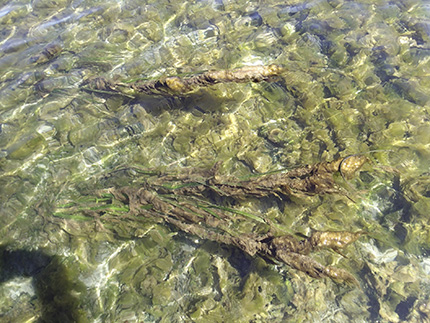
While healthy Eelgrass meadows may provide local amelioration of the detrimental effects of ocean acidification, degraded meadows, such as this likely have little impact on ocean pH. Photo: Maya Groner (UPEI)
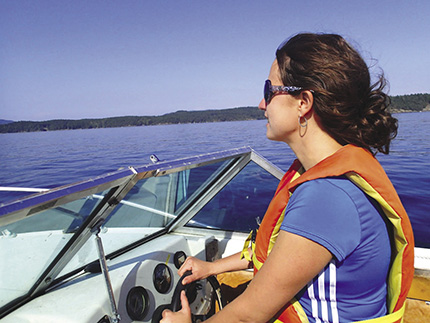
Maya Groner seagrass sampling. Photo: Maya Groner (UPEI)
IMPACTS OF AQUACULTURE OPERATIONS ON THE GENETIC HEALTH OF NATURAL POPULATIONS OF THE EASTERN OYSTER, CRASSOSTREA VIRGINICA
This information will allow for both a better assessment of the genetic health of Crassostrea virginica populations in the Maritimes, and for the establishment of hatchery-based breeding programs.
Oyster farmers currently rely on wild-caught seed to stock their aquaculture sites. The number and quality of seed, however, is highly variable from year-to-year and juvenile oysters must often be sold and transported from regions with a high seed set (abundance) to regions with a poor seed set. To address this issue, a commercial-scale hatchery in New Brunswick is currently being developed to provide adequate spat (oyster seed) to oyster farms within the Maritimes. The potential impact of hatchery-spawned oysters, as well as transplanted wild-caught spat, on the genetic integrity of neighboring wild oyster beds greatly depends on the factors underlying the genetic structure of natural populations. Conversely, the health and vigour of cultured oysters depends on the quality of available spat, whether from wild-caught sources or hatchery production. Additionally, this project will examine genetic diversity between populations of the Eastern Oyster, identify functional diversity in terms of health indicators such as condition index, growth, survival, and reproduction, as well as evaluate the potential impacts of gene flow between wild and cultivated oyster populations.
The goal of this project is to evaluate the genetic sequence of natural oyster populations through the creation of a high-density linkage map for the molecular markers associated with functional diversity in the Eastern Oyster.
Apr. 2013–Mar. 2017
Funded By: DFO – Aquaculture Collaborative Research and Development Program (DFO – ACRDP) Co-Funded By: L’Étang Ruisseau Bar Ltd.
Project Lead: Mark LaFlamme (DFO)
Collaborators: L’Étang Ruisseau Bar Ltd.
Contact: Mark.LaFlamme@dfo-mpo.gc.ca
www.dfo-mpo.gc.ca/aquaculture/acrdp-pcrda/index-eng.htm
INVESTIGATION INTO THE SURVIVAL AND SPAWNING POTENTIAL OF THE SELECTED F1 OYSTERS: FOLLOW UP TO THE BRAS D’OR LAKES OYSTER BREEDING PROGRAM FOR MSX
This project will allow Fisheries and Oceans Canada to protect this distinct oyster population, while supporting the sustainable growth of the oyster farming industry in Nova Scotia.
Native American Oyster (Crassostrea virginica) populations in the Bras d’Or Lakes region of Nova Scotia have been in decline due to a combination of over-fishing, degradation of habitats and most recently, the appearance of the MSX parasite (Haplosporidium nelsoni) and the Malpeque disease. There is a need to rejuvenate the depleted private aquaculture leases and public oyster beds, however, the importation of oysters from outside the Bras d’Or Lakes is currently not permitted in order to protect the native oysters from exposure to these diseases. Aquaculture and commercial growers must then rely on resident populations for future culture and wild population enhancement activities. Recent research on this issue has initiated a selective breeding program designed to provide the necessary disease resistant/tolerant spat to rebuild the native population. This project will determine the spawning potential and survivorship of first generation (or F1) bred to be resistant/tolerant to MSX to support restoration efforts within the Bras d’Or Lakes and ultimately Atlantic Canada should the MSX parasite be discovered elsewhere.
Apr. 2013–Mar. 2015
Funded By: DFO – Aquaculture Collaborative Research and Development Program (DFO – ACRDP) Co-Funded By: Eskasoni Fish and Wildlife Commission
Project Lead: Benedikte Vercaemer (DFO)
Collaborators: Eskasoni Fish and Wildlife Commission
Contact: Benedikte.Vercaemer@dfo-mpo.gc.ca
www.dfo-mpo.gc.ca/aquaculture/acrdp-pcrda/index-eng.htm
IMPROVING PHYSIOLOGICAL HEALTH OF OYSTERS BY SELECTING SEED FOR STRESS RESILIENCE
Having efficient and resilient oysters will ensure that if faced with a pathogen or environmental stressor, oysters will have an increased capacity to launch an immune response to pathogens.
Successful oyster culture is dependent on the use of seed that can grow well in both optimal and stressful environmental conditions. The amount of energy reserves, or the ability to produce energy from food intake, dictates how long shellfish can survive in a stressful environment or when challenged by a disease. Access to a consistent supply of high quality and resilient seed stocks (i.e., those with the capacity to launch an immune response when faced with pathogens or withstand fluctuations in salinity and temperature associated with climate change) has been identified as a key constraint for the continued viability and expansion of the Eastern Oyster industry in Atlantic Canada. Selecting oysters that are more efficient (lower metabolic need, better feed conversion, and lower reproductive effort) and have increased resistance to deal with stressful events (lower stress response) will ultimately be healthier and thus have greater resilience to pathogens and environmental changes. This project will identify genetic markers in the Eastern Oyster associated with metabolic and feed conversion efficiency with the goal of producing a first generation crop of oysters that display these particular traits and monitor their success under various growing conditions.
Apr. 2014–Mar. 2017
Funded By: DFO – Aquaculture Collaborative Research and Development Program (DFO – ACRDP) Co-Funded By: L’ Écloserie Acadienne Ltd.
Project Lead: Denise Méthé (DFO)
Collaborators: L’Écloserie Acadienne Ltd.
Contact: Denise.Methe@dfo-mpo.gc.ca
www.dfo-mpo.gc.ca/aquaculture/acrdp-pcrda/index-eng.htm
IMPROVING OYSTER (CRASSOSTREA VIRGINICA) SEEDSTOCK PRODUCTION IN NOVA SCOTIA
The demand for oyster in the USA and European markets is increasing, but the traditional sources of supply have been faced with increasing stresses due to both anthropological causes (e.g., oil spill in the Gulf of Mexico) and extreme environmental changes. The international markets are seeking supply from Canadian waters, but the production of oysters in Atlantic Canada, particularly from Nova Scotia, could not cope with the increasing demand. Recognizing this great market opportunity, the shellfish producers in Nova Scotia approached NS Department of Fisheries and Aquaculture (NSDFA) and the Aquaculture Centre at Dalhousie University to assist the industry to improve oyster production in the province. With financial assistance from NSDFA and Gulf Aquaculture Association (GAA), Jesse Ronquillo and his research team developed innovative hatchery procedures for improved method in oyster seedstock production using various spawning induction techniques and continuous production of selected microalgal species rich in omega-3 fatty acids for faster growth and increased survival rate of seedstock. More than 500 million pediveligers or eyed-larvae were produced for remote setting and grow-out operations of shellfish growers in Northumberland Strait.
The inexpensive and innovative hatchery production techniques developed through the collaborative project can be adopted by shellfish growers to produce oyster seedstock without extensive investment on costly infrastructure and equipment. The use of newly developed technology for the production of healthy and good quality oyster seedstock for remote setting will enhance shellfish production in Nova Scotia.
Mar. 2012–Oct. 2012
Funded By: Nova Scotia Department of Fisheries and Aquaculture (NSDFA) Co-Funded By: Gulf Aquaculture Association (GAA)
Project Lead: Jesse Ronquillo (UBC)
Project Team: Audrie-Jo McConkey (Dalhousie U)
Collaborators: Paul Budrewski (GAA); Ronakkumar Desai (Dalhousie U)
Contact: Jesse.Ronquillo@ubc.ca

Spawning and seedstock production of American Oyster. Photo: Jesse Ronquillo (UBC)
ASSESSMENT OF OYSTER SPAT COLLECTION POTENTIAL IN BOUCTOUCHE BAY, NEW BRUNSWICK
Results from this study will help inform the spat collection in Bouctouche Bay and the management of oyster seed on a larger scale to assist the development of the New Brunswick oyster culture industry.
The oyster culture industry is an economic sector in active development in eastern New Brunswick. In the southern part of this region, the industry relies quasi-entirely on a single spat collection site located in Bouctouche Bay to acquire its stocks. Little is known about the influence of environmental conditions on the success of spat collection in this bay. In the context of this project, an FVCOM hydrodynamic model is presently being developed to represent the circulation within the bay and its exchange with the Gulf of Saint Lawrence under natural forcing. A particle tracking model will then be used to reproduce the transport of oyster larvae. Different scenarios will be tested to investigate the effects of environmental forcing (wind, river discharge), as well as the influence of the potential future changes in the geomorphology of the sand barrier enclosing Bouctouche Bay on the oyster larvae distribution at the time of settlement.
Apr. 2013–Mar. 2015
Funded By: DFO – Aquaculture Collaborative Research and Development Program (DFO – ACRDP) Co-Funded By: Entreprise Baie Acadienne Ltd.
Project Lead: Thomas Guyondet (DFO)
Project Team: Luc Comeau (DFO); Marie-Josée Maillet (Department of Agriculture, Aquaculture and Fisheries, NB); Serge Jolicoeur (U Moncton); Dominique Bérubé (Department of Natural Resources, NB)
Collaborators: Serge Leblanc (Entreprise Baie Acadienne Ltd.)
Contact: Thomas.Guyondet@dfo-mpo.gc.ca
www.dfo-mpo.gc.ca/aquaculture/acrdp-pcrda/index-eng.htm

Map of Bouctouche Bay, NB, showing the narrow, elongated sand barrier and locations of wild oyster populations, oyster farms, and the spat collection area. Photo: Thomas Guyondet (DFO)
ASSESSING SEASONAL VARIATIONS IN THE PHYSIOLOGICAL HEALTH OF THE EASTERN OYSTER, CRASSOSTREA VIRGINICA
Cumulative mortality is a major issue within oyster culture. Under optimal conditions, a mortality of 5% per year is often observed, however, these numbers can vary considerably between lease sites. Producers compensate for these losses by increasing the number of oysters cultivated on their leases. However, increasing the number of oysters on each lease can greatly impact the environmental footprint of the site. Valuable resources within the ecosystem are lost (e.g., phytoplankton, nutrients, etc.) and on-site biodeposition is increased, without any return to the industry or consumers in terms of more oysters. This environmental impact becomes even greater in areas of reduced water exchange and areas of maximised carrying capacity. In New Brunswick, oyster mortalities appear to be closely related to environmental factors (e.g., temperature, salinity, etc.) and husbandry or rearing practices. The physiological health of the animal can determine how well it adapts and recovers from exposure to potential stressors. This study will assess variations in the health and condition of oysters (Crassostrea virginica) in New Brunswick in response to environmental changes to identify critical periods of physiological stress. This information will allow the development of management plans and best practices to help oyster producers avoid supplementary stressors, thus reducing mortalities and optimizing resource utilization. This could lead to more environmentally responsible operating practices for the oyster culture industry.
Apr. 2012–Mar. 2015
Funded By: DFO – Aquaculture Collaborative Research and Development Program (DFO – ACRDP) Co-Funded By: La Maison Beausoleil Inc.
Project Lead: Daniel Bourque (DFO)
Collaborators: La Maison Beausoleil Inc.
Contact: Daniel.Bourque@dfo-mpo.gc.ca
www.dfo-mpo.gc.ca/aquaculture/acrdp-pcrda/index-eng.htm
DEVELOPMENT OF TOOLS TO EVALUATE AMERICAN OYSTER, CRASSOSTREA VIRGINICA, SHELF LIFE
Growers in Atlantic Canada have indicated that there are seasonal variations in oyster shelf life. Therefore, there was a need for the development of simple and reliable shelf life evaluation and prediction tools to ensure quality. This research focused on the development of tools or techniques to determine the shelf life of oysters (Crassostrea virginica) and predict oyster shelf life prior to storage. Several instruments and techniques were evaluated to verify their usefulness in determining and predicting oyster shelf life. The tools were chosen keeping in mind that they should be practical for use by the industry. The objective of developing these tools was to permit industry to confidently stamp their product with a best before date to assure high product quality.
The osmometer, salinity refractometer, ion selective ammonia probe, and possibly pH meter were identified as potential tools for evaluating oyster shelf life during cold storage. Although the total protein refractometer and Brix meter (for sugar content measurement) were not identified as definite tools for predicting oyster shelf life, it is felt that protein and sugar concentrations in the oysters blood still have the potential to be useful indicators. Additional studies on seasonal variations while taking into account environmental conditions (e.g., salinity) at sample sites are required to validate these potential tools.
The tools developed through this research will help the aquaculture industry to determine the shelf life and quality of oysters before they are marketed. These tools coupled with future research on seasonal variations in shelf life should allow the shellfish aquaculture industry to confidently apply a best before date to their product based on time of harvest to assure the quality of the product.
Apr. 2011–Mar. 2013
Funded By: DFO – Aquaculture Collaborative Research and Development Program (DFO – ACRDP) Co-Funded By: La Maison BeauSoleil Inc.
Project Lead: Daniel Bourque (DFO)
Collaborators: La Maison BeauSoleil Inc.
Contact: Daniel.Bourque@dfo-mpo.gc.ca
www.dfo-mpo.gc.ca/aquaculture/acrdp-pcrda/index-eng.htm
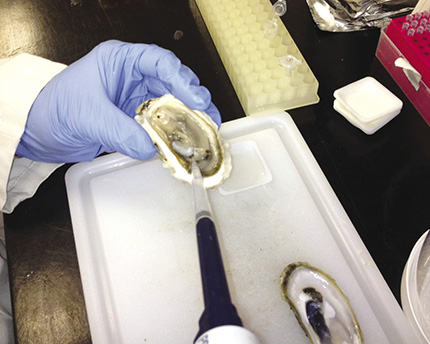
Sampling oyster hemolymph (blood) for assessment of potential shelf life evaluation tools. Photo: Daniel Bourque (DFO)
DEVELOPMENT OF A MODIFIED ASSAY FOR USE IN TEMPERATE WATERS AND ITS APPLICATION THROUGH AN ASSESSMENT OF STRESS TOLERANCES AMONG OYSTER STOCKS (CRASSOSTREA VIRGINICA) WITH VARYING LEVELS OF HETEROZYGOSITY
Many factors can contribute to oyster mortality and for the most part these factors are related to stress. Biomarkers that detect stress levels in oysters can help mitigate oyster losses leading to greater sustainability and productivity for the aquaculture industry. The neutral red retention assay (NRA) is a general biomarker that can detect stress-related responses (lysosomal membrane destabilization) before other disturbances such as disease, mortality, or population level changes occur. This study explored the validity of a modified NRA for use in temperate waters and evaluated the seed quality of oyster stocks from eastern New Brunswick using metabolic rate measurements, multi-locus heterozygosity, and thermal stress response (using NRAMOD) as indicators.
The effect of hemolymph osmolality on the NRA outcome in oysters exposed to low water temperatures was verified in a controlled setting. Based on these findings, it is proposed that NRAMOD, which uses filtered mantle fluid of the oysters, be used as an alternative to NRA when measuring lysosomal membrane destabilization of oysters in cold water.
Physiologically fit oysters that maintain vital functions with less energy have more energy available to dedicate to stress responses and in turn show lower mortality rates. Based on metabolic measurements and thermal stress responses (using NRAMOD), our results suggest that oyster stocks from the prominent collection areas in eastern New Brunswick (Caraquet, Miramichi, and Bouctouche) are similar in terms of their physiological fitness. However, Miramichi oyster stocks had a significantly lower level of heterozygosity compared to the other stocks. For this reason, the aquaculture industry in New Brunswick may benefit from further examination into survival curves of Miramichi oyster stocks under stressful conditions as a means to provide further clarify on seed quality.
Apr. 2011–Mar. 2013
Funded By: DFO – Aquaculture Collaborative Research and Development Program (DFO – ACRDP) Co-Funded By: Elsipogtog Fisheries
Project Lead: Carla Hicks (DFO)
Collaborators: Elsipogtog Fisheries
Contact: Carla.Hicks@dfo-mpo.gc.ca
www.dfo-mpo.gc.ca/aquaculture/acrdp-pcrda/index-eng.htm
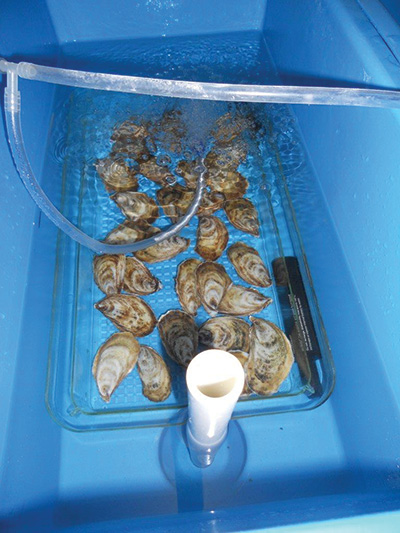
Oysters (Crassostrea virginica) in treatment tanks during laboratory experiment. Photo: Denise Méthé (DFO)
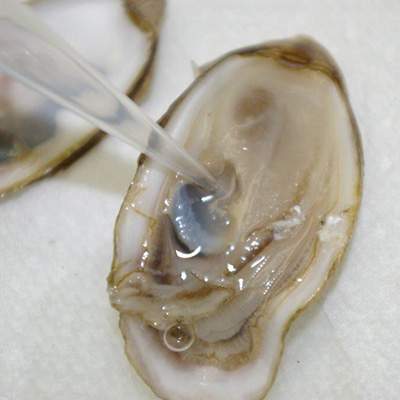
Sampling hemolymph from pericardial cavity of an oyster (Crassostrea virginica) with a pipette. Photo: Denise Méthé (DFO)
DIETS OF BOTTOM AND SUSPENDED OYSTERS
Oyster aquaculture in Prince Edward Island (PEI) is changing from traditional bottom to suspended culture methods. There are several advantages to suspending oyster stocks in the upper water column. This strategy protects stock from benthic predators and enhances growth by positioning oysters in a relatively warm and elevated food flux environment. In addition, oysters grown in suspension have a tendency to develop round shells ornamented with radial ridges and foliated processes. By contrast, oysters grown on soft, muddy bottoms tend to develop elongated and sparsely ornamented shells.
Several lease holders in the Trout River (PEI) system are seeking to convert from bottom to suspended culture. To improve the parameterization of carrying capacity models, this project evaluated whether bottom and suspended oysters compete for the same food resources within the system. Fatty acid analyses revealed that microalgae is the major (70%) dietary constituent, regardless of the culture technique. However, bottom oysters consumed more diatoms and less flagellates when compared to suspended oysters. Therefore an oyster’s diet is dependent in part upon the cultivation technique.
May 2012–Mar. 2015
Funded By: DFO – Program for Aquaculture Regulatory research (DFO – PARR)
Project Lead: Rémi Sonier (DFO)
Project Team: Luc Comeau, Thomas Guyondet (DFO); Réjean Tremblay (UQAR/ISMER)
Contact: Remi.Sonier@dfo-mpo.gc.ca

Morphology of a suspension grown oyster (left) vs. a bottom grown oyster (right). Photo: Luc Comeau (DFO)
EARLY CONDITIONING OF AMERICAN OYSTER (CRASSOSTREA VIRGINICA)
The ability to control the spawning period is one of the main advantages of hatcheries, especially for those producing animals cultured in the wild later on, such as the American Oyster (Crassostrea virginica). An early spawning allows transferring larger animals at the beginning of the natural growth period, which can reduce the production cycle by up to one year. The present project will look at the effects of broodstock overwintering periods of two and four weeks, broodstock fattening periods of two and four weeks, and the combination of both variables. Results will serve to develop a protocol on oyster broodstock conditioning and produce quality larvae in November of each year (i.e., almost eight months before spawning in nature). The number of eggs, the percentage of D-stage larvae recovered as well as the survival and growth at seven days will be monitored and considered as success indicators. A spawning in November could allow transferring 15-20 mm spats to grow-out sites in early May.
Apr. 2014–Apr. 2015
Funded By: New Brunswick Department of Agriculture, Aquaculture and Fisheries (NBDAFF)
Project lead: Rémy Haché (CZRI)
Project Team: Mélanie DeGrâce, Raoul Lanteigne, Pascale Comeau, André Dumas (CZRI)
Contact: Remy.Hache@irzc.umcs.ca
AMERICAN OYSTER (CRASSOSTREA VIRGINICA) GENETIC SELECTION PROGRAM AT THE COASTAL ZONES RESEARCH INSTITUTE
The first phase of the American Oyster (Crassostrea virginica) breeding program is to produce at least 100 families for each one of the three populations of origin in order to create a robust basis for effective and sustainable genetic selection. The Coastal Zones Research Institute (CZRI) works with three different populations coming from three different bays: Bouctouche, Caraquet, and Miramichi. Individuals collected randomly in those bays and reared at nearby aquaculture sites have been used as broodstock. Breeding success is rather low for shellfish due to gamete incompatibility, a phenomenon commonly observed with marine invertebrates. Therefore, half-sib breeding schemes have been adopted were one male fertilises three different females separately. From the 109 crosses performed in 2014, 20 families were transferred to sea. The number of families was five from Bouctouche, five from Caraquet and ten from Miramichi. From the experience gained in 2014, the team at CZRI expects to produce a total of 100 families in 2015.
May 2012–Aug. 2014
Funded By: New Brunswick Department of Agriculture, Aquaculture and Fisheries (NBAAF)
Project Lead: Rémy Haché (CZRI)
Project Team: Mélanie DeGrâce, Raoul Lanteigne, Pascale Comeau (CZRI)
Contact: Remy.Hache@irzc.umcs.ca

Research platform, CCGS Vector, working in Baynes Sound, British Columbia. Photo: Dan McPhee (DFO)
- Date modified: